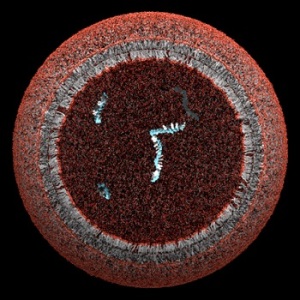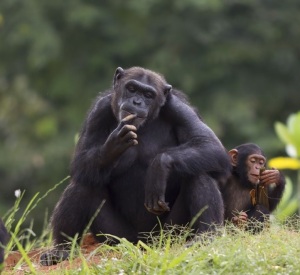Religious Naturalism
Taking Nature to HeartLife
In a naturalist view, life is a wholly biological process. Some aspects of this can give a sense of wonder; some others can raise questions and concerns. Ways that we appreciate and wrestle with a sense of what we are can be part of being religious.
 Part of the nature of life traces back to origins, where life is thought to have emerged when types of nucleotides (similar to RNA) formed in ways that were able to copy themselves. When these were surrounded by a lipid membrane, they acted as protocells, taking in nutrients and converting these to energy, to form proteins and act in ways that enabled the cell to reproduce.
Part of the nature of life traces back to origins, where life is thought to have emerged when types of nucleotides (similar to RNA) formed in ways that were able to copy themselves. When these were surrounded by a lipid membrane, they acted as protocells, taking in nutrients and converting these to energy, to form proteins and act in ways that enabled the cell to reproduce.
For hundreds of millions of years, single cells were the only forms of life – all composed of the same few substances (carbohydrates, fats, proteins, adenosine phosphates, nucleic acids, and water) which, in turn, are composed of a small number of atoms (carbon, hydrogen, nitrogen, oxygen, phosphorus, and sulphur). As one author put it, the chemistry of life is the chemistry of carbon and water.
A major change occurred as cells mutated in ways that enabled them to act together. In time, these evolved into millions of forms of multi-cellular life – some as plants, some as animals, and some including specialized nerves that formed as complex brains. These all grow, mature, reproduce, and interact. All are attracted to things that are good for them and avoid what may cause harm. Some have impressive abilities – in perception, problem solving, and ways of acting in social groups. But, a price is paid in return as, unlike single cells that can reproduce and live forever, the varied cells that enable complex life require that these beings all must die.
Some aspects of this view can feel deflating. Rather than being created in the image of an all-knowing and loving God, life can be seen as types of chemical reactions. But this has a flip side, with a sense of wonder at the intricate processes involved, and the more we learn, the more we may be amazed and impressed. As Fritjof Capra described this:
 “When we look at the world around us, we find that we are not thrown into chaos and randomness but are part of a great order, a grand symphony of life. Every molecule in our body was once part of previous bodies – living or nonliving – and will be a part of future bodies. In this sense, our body will not die but will live on, again and again, because life lives on. We share not only life’s molecules but also its basic principles of organization with the rest of the living world. And since our mind, too, is embodied, our concepts and metaphors are embedded in the web of life together with our bodies and brains. We belong to the universe, we are at home in it, and this experience of belonging can make our lives profoundly meaningful.”
“When we look at the world around us, we find that we are not thrown into chaos and randomness but are part of a great order, a grand symphony of life. Every molecule in our body was once part of previous bodies – living or nonliving – and will be a part of future bodies. In this sense, our body will not die but will live on, again and again, because life lives on. We share not only life’s molecules but also its basic principles of organization with the rest of the living world. And since our mind, too, is embodied, our concepts and metaphors are embedded in the web of life together with our bodies and brains. We belong to the universe, we are at home in it, and this experience of belonging can make our lives profoundly meaningful.”
 A biologic view of life has led to “miraculous” medical advances that, along with relieving suffering and prolonging life, include new possibilities, with in vitro conception, transplantation of organs, and potential for cloning and genetic manipulation.
A biologic view of life has led to “miraculous” medical advances that, along with relieving suffering and prolonging life, include new possibilities, with in vitro conception, transplantation of organs, and potential for cloning and genetic manipulation.
A biologic view also highlights things we share with other creatures, with some common tendencies and needs and, with primates and some other mammals, similar types of awareness and feelings.
This view also puts focus on ways that living things all nourish and depend on one another, and how, in ways we are only beginning to understand, the well-being of humans depends on other living things in complex ecosystems.
Links
Exploring Life’s Origins (Boston Museum of Science)
The Line Between Life and Non-Life (TED talk, Martin Hanczyc)
Biology: What One Needs to Know
Emergence (Wikipedia)
Life’s Greatest Miracle (NOVA video)
What is Life? How Chemistry Becomes Biology – Addy Pross (2016)
Taking Nature to Heart
A worldview grounded in science that provides a foundation for a way of being in the world that is both inspiring and personally rewarding.